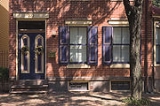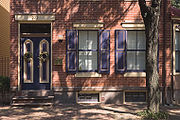
Mill Hill, Trenton, New Jersey
Encyclopedia

New Jersey
New Jersey is a state in the Northeastern and Middle Atlantic regions of the United States. , its population was 8,791,894. It is bordered on the north and east by the state of New York, on the southeast and south by the Atlantic Ocean, on the west by Pennsylvania and on the southwest by Delaware...
's capital city of Trenton, New Jersey
Trenton, New Jersey
Trenton is the capital of the U.S. state of New Jersey and the county seat of Mercer County. As of the 2010 United States Census, Trenton had a population of 84,913...
.
The name Mill Hill refers to central New Jersey's first industrial site, a mill, erected in 1679, at the southeast corner of the present Broad Street crossing of the Assunpink Creek
Assunpink Creek
Assunpink Creek is a tributary of the Delaware River in western New Jersey in the United States.Assunpink Creek is born in rural Monmouth County, about a mile north of Clarksburg. Flowing westwards, it soon enters the Assunpink Wildlife Management Area, where it has been dammed to form Rising Sun...
. Mill Hill and its wooden mill were among the holdings of the first settler in the vicinity of Trenton, Mahlon Stacy, who arrived in North America in 1678. The mill was destroyed in a flood.
Mill Hill became famous in the late 18th century for being the site of the Second Battle of Trenton
Second Battle of Trenton
The Battle of the Assunpink Creek, also known as the Second Battle of Trenton, was a battle between American and British troops that took place in and around Trenton, New Jersey, on January 2, 1777, during the American Revolutionary War, and resulted in an American victory.Following a surprise...
, a battle many historians consider the turning point in the American Revolutionary War
American Revolutionary War
The American Revolutionary War , the American War of Independence, or simply the Revolutionary War, began as a war between the Kingdom of Great Britain and thirteen British colonies in North America, and ended in a global war between several European great powers.The war was the result of the...
. The battle took place on January 2, 1777, in what is now Mill Hill Park. Every year, this battle is re-enacted during Patriots Week in Trenton.
Mill Hill remained relatively undeveloped during the first decades of the 19th century. During this time it was not yet part of the City of Trenton. In 1840, the entire area was incorporated as South Trenton
South Trenton
South Trenton is a neighborhood in Trenton, New Jersey, United States, that is home to a diverse array of immigrants from places such as Italy, Latin America, and Ireland and their ancestors. It is Trenton's most diverse neighborhood and borders Hamilton Township to the Southeast and the Delaware...
and then into the City of Trenton in 1851. The name Mill Hill was applied to the area at least as early as 1821.
Mill Hill grew rapidly during the 19th century as Trenton grew into an industrial center of some note. The Roebling steel works made the wire cables used to construct most of the major bridges built in the United States, including the Golden Gate Bridge
Golden Gate Bridge
The Golden Gate Bridge is a suspension bridge spanning the Golden Gate, the opening of the San Francisco Bay into the Pacific Ocean. As part of both U.S. Route 101 and California State Route 1, the structure links the city of San Francisco, on the northern tip of the San Francisco Peninsula, to...
and George Washington Bridge
George Washington Bridge
The George Washington Bridge is a suspension bridge spanning the Hudson River, connecting the Washington Heights neighborhood in the borough of Manhattan in New York City to Fort Lee, Bergen County, New Jersey. Interstate 95 and U.S. Route 1/9 cross the river via the bridge. U.S...
. Trenton was also the principal center of the pottery and ceramic industry in the United States.
The population of Mill Hill swelled rapidly, enhanced by immigration. By 1920, 52% of the city's population were foreign-born.
During the Great Depression
Great Depression
The Great Depression was a severe worldwide economic depression in the decade preceding World War II. The timing of the Great Depression varied across nations, but in most countries it started in about 1929 and lasted until the late 1930s or early 1940s...
, Trenton started to decline. By 1953 Roebling Steel was one of Trenton's last great manufacturers to be sold to another company and then closed.
Since the early 1980s, Mill Hill has been undergoing a revitalization. This was enabled by a redevelopment plan based around the idea of converting Mill Hill into a latter-day "Georgetown". Instead of replacing the historical fabric of the area, the buildings were to be preserved and renovated. The red brick row-houses - constructed in the late 19th century - have been restored, in many cases being converted back to single-family homes (many had been converted to multi-family rental properties during less prosperous times). In a symbolic act that ended up carrying significant weight for the neighborhood, the then Mayor of Trenton, Arthurr J. Holland, moved his family to 138 Mercer Street in 1964. "Mayor Arthur Holland and his young wife were idealistic newlyweds with a baby daughter in 1964 when they decided to restore a house in Trenton's crumbling, if historic, Mill Hill neighborhood." The restoration of the area has proceeded in waves ever since.
Initially focused on the 100 blocks of Mercer and Jackson Streets, some residents began renovating their homes. In 1967, the first Holiday House Tour took place. The tour became an annual event that continues today, attracting more than 1,000 people who tour the historic homes. With these changes came improving house prices, more investment and more restoration.
After the property collapse of the late 1980s, a second wave of renovation started. Commercial developers, led by Atlantis Historic Properties, took up renovating the vacant properties on the 200 blocks of Mercer, Jackson and Clay streets. Atlantis was formed by the members of the Mill Hill community themselves (in the early 1990s) to preserve and restore the historic homes - starting with the properties at 261 and 263 Jackson Street.
Today, renovated historic structures and historically sensitive new construction stand side by side.

